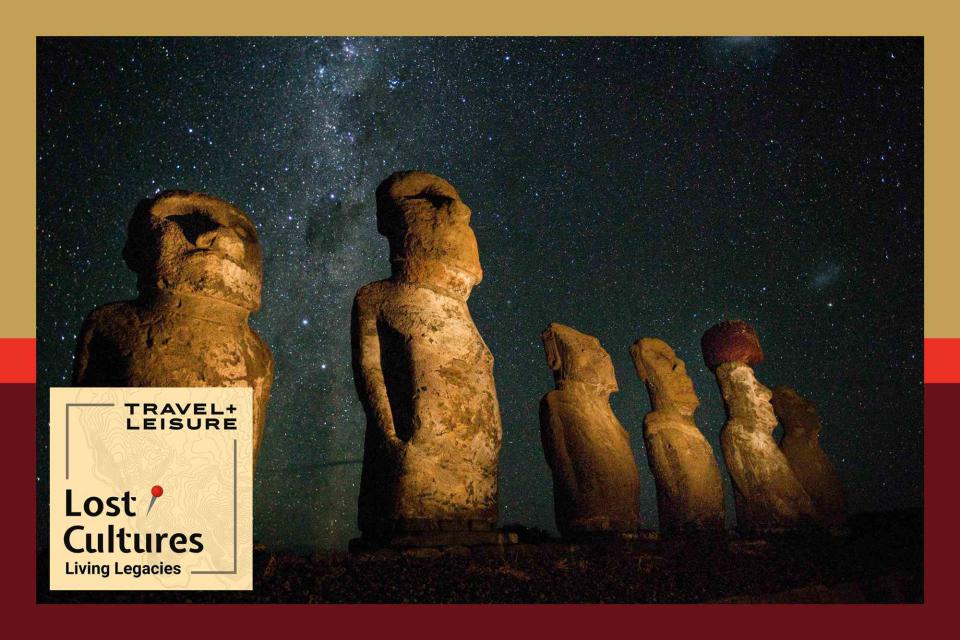Exploring the Fascinating History of Rapa Nui — and How It Became Known as Easter Island
Learn how they moved those massive maoi heads in this week's episode of Lost Cultures: Living Legacies.

Amy Toensing/Getty Images
Every Wednesday on the Lost Cultures: Living Legacies podcast, host Alisha Prakash, Travel + Leisure's associate editorial director, explores a unique cultural identity around the world and shares how you can learn more about it on your travels, too.
Perhaps you’ve heard of Easter Island. You may have even seen images of those giant stone statues, known as moai, that stoically stare off into the distance. But what you may not know about this place is that its proper name isn’t Easter Island at all. It’s Rapa Nui, the same name as the people who have long called the island home.
“If I were to describe the Rapa Nui culture to somebody, I would say that we come from an ancient group of people that lived in the Pacific Ocean. When you look at a map of the world, you see all these land masses, all these big continents, right? North America, South America, Africa, all that, but people don't see the Pacific Ocean as, in a sense, where people would live,” Sergio Mata'u Rapu, a documentary filmmaker from Rapa Nui, shares. “Typically, a map cuts the Pacific Ocean in half, and our continent, our world for Polynesians, is that Pacific Ocean. There are thousands of islands in that big, blue space that was home to my ancestors. And so I would start there because I think what makes Rapa Nui unique is what makes islanders unique.”
And, as Mata'u Rapu explains, this unique group was here far before their home was renamed without them.
“An early Dutch explorer, 1722, ‘rediscovers,’ I'll say, Rapa Nui. It's on Easter Sunday. So he's like, ‘Hey, we'll call it Easter Island.’ And then the name kind of sticks, but our community was thriving, and creating, prior to his arrival. And continued to do so way after,” he says. “But that thread of understanding of where we come from, and what's important, our priorities are still there. We just don't wear loincloths anymore. We've sort of traded those out for blue jeans ‘cause maybe they're a little bit more practical now.”
As for those famous heads, Mata'u Rapu adds that the Rapa Nui are known as an “ancestor cult,” which worships their elders and ancestors over anything else. “Our culture teaches us that we learn from and respect those elders, and so that's the significance of the moai, that is why the moai were built, that's why they were placed in front of our villages in ancient times.”
But just how did they get there in the first place? According to Carl Lipo, a professor of anthropology at Binghamton University in Upstate New York (whose work includes actually walking a moai head down a street), it’s all thanks to some very impressive math skills.
“One of the things we underestimate is the fact that people in the past were as clever as us,” Lipps says. “They knew about, and would utilize, the center of mass, for example, the physical properties of rock. And so, if you use the center of mass, you can rock and tilt things without a lot of effort. Now, if we had to move a gigantic statue, we'd get a giant crane, pick it up and move it. Without those things, you would experiment with as many ways as you could do it and try to find the easiest way that's possible. And really, that's what the past people did, and it's how they achieved some of these remarkable things.” Importantly, he adds, “It wasn't because it was space aliens. It's just that they were good at it. They figured it out, and, the challenge to us is to figure out how they did it. And this is where we can learn a lot from our past.”
To learn more about the Rapa Nui, listen to Prakash's conversation with guests Sergio Mata’u Rapu and Professor Carl Lipo in Lost Cultures: Living Legacies, available on Apple Podcasts, Spotify, Amazon Music, and everywhere podcasts are available.
Editor's Note: Please be mindful that this transcript does not go through our standard editorial process and may contain inaccuracies and grammatical errors.
For more Travel & Leisure news, make sure to sign up for our newsletter!
Read the original article on Travel & Leisure.

